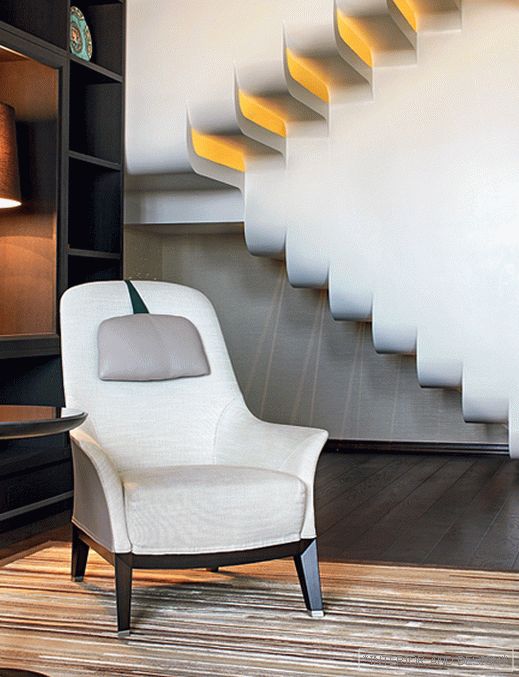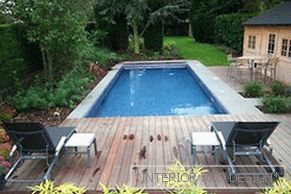 Each owner of the suburban area seeks to maximally ennoble him and create all conditions for a comfortable and enjoyable pastime. Therefore, it is not surprising that today the issue of arranging your own pool has become extremely relevant. More recently, structures of this type were some kind of luxury that far from every person could afford, but with the advent of new technologies and materials, such pleasure became quite real and more than affordable.
Each owner of the suburban area seeks to maximally ennoble him and create all conditions for a comfortable and enjoyable pastime. Therefore, it is not surprising that today the issue of arranging your own pool has become extremely relevant. More recently, structures of this type were some kind of luxury that far from every person could afford, but with the advent of new technologies and materials, such pleasure became quite real and more than affordable.
Content
- 1 Types of pools for summer cottage
- 2 Advantages and disadvantages of plastic pools
- 3 Cost of plastic pools
- 4 Technology installation of a plastic pool in the country
- 5 In conclusion
Types of pools to give
The choice of any particular type of basin is exclusively individual, as in this matter it is necessary to take into account a number of parameters, in particular, the area of free space that can be allocated to the design, soil features, frequency of use of the pool, personal preferences and, of course, financial opportunities. Therefore, first of all, you should consider what kind of pools there are and what are their essence.
So, all possible options for these water structures can be divided into the following groups:
-
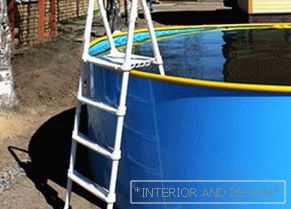 Stationary pools. This is a classic option, for arranging which the excavation of the necessary parameters is dug, work is carried out to prepare the base and set up either ready bowls, or pour concrete into a special form. The technology of creating a concrete pool implies a number of fairly complex and lengthy activities, since it is necessary not only to pour concrete solution into the quality, but also to perform finishing work. But at the same time, such designs are considered durable, solid and allow you to create absolutely any configuration. In addition, if the pool is supposed to be placed inside an already existing room, this option can be called the only possible one. Today, the most popular are plastic swimming pools, which are reservoirs of predetermined parameters and forms, which are fairly simple to install and after connecting all communications equipment are fully operational.
Stationary pools. This is a classic option, for arranging which the excavation of the necessary parameters is dug, work is carried out to prepare the base and set up either ready bowls, or pour concrete into a special form. The technology of creating a concrete pool implies a number of fairly complex and lengthy activities, since it is necessary not only to pour concrete solution into the quality, but also to perform finishing work. But at the same time, such designs are considered durable, solid and allow you to create absolutely any configuration. In addition, if the pool is supposed to be placed inside an already existing room, this option can be called the only possible one. Today, the most popular are plastic swimming pools, which are reservoirs of predetermined parameters and forms, which are fairly simple to install and after connecting all communications equipment are fully operational. - Ground бассейны. Достаточно популярный вид бассейнов, который отличается простотой установки и гораздо меньшей the costю в сравнении с предущим вариантом. TOак правило, имеет овальную, прямоугольную или круглую форму. В зависимости от материала изготовления такие басейны могут быть двух видов, в частности с мягкими (из резины и латекса) и жесткими стенками (полипропилен и стекловолокно). Ground бассейны устанавляваются, если участкок имеет неподходящий рельеф и тип грунта, а также в случае наличия маленьких детей и домашних животных, которые могут упасть в него.
- Frame pools. They are prefabricated structures, which are located directly on a special litter located on the surface of the earth, without the need for digging and arranging the pit,
that is, installation of the frame pool will not make special work. PVC coating with waterproof properties, is mounted on the frame, thus creating a reservoir for filling water. They can be quite large, additionally equipped with a ladder for lifting and descending into the pool and a water filter. Of course, such pools less durable in comparison with stationary structures, but considering their cost, convenience and mobility, their purchase becomes quite reasonable. - Inflatable pools. Perhaps this is the most affordable and simple option, consisting of several rings, which, using a manual or electric pump, inflate and form a container for making water treatments. They have a small size and a high degree of susceptibility to the influence of negative external factors. Often, this acquisition is advisable if there is no functional place or appropriate financial capacity for the construction of a full-fledged structure, and the desire to pamper your family with a pool is still present.
Advantages and disadvantages of plastic pools
 Plastic pools occupy a leading position in sales and there are a number of reasons for this, which will be discussed in detail a little later. Depending on the material produced two types of plastic pools, namely, polypropylene and composite. It is difficult to say which option is better, since their properties are quite similar, but polypropylene pools are in great demand among domestic consumers, mainly due to lower cost.
Plastic pools occupy a leading position in sales and there are a number of reasons for this, which will be discussed in detail a little later. Depending on the material produced two types of plastic pools, namely, polypropylene and composite. It is difficult to say which option is better, since their properties are quite similar, but polypropylene pools are in great demand among domestic consumers, mainly due to lower cost.
Part composite pools includes fiberglass, polymer resins and composite compounds. Manufacturing technology is difficult, but thanks to it, you can add a pool of various elements in the form of steps, podiums, stove beds, and in general give fancy shapes to the tank. Polypropylene pools can have both monolithic and composite structures, the elements of which are joined by thermal welding. They are made of special plastic plates, the thickness of which varies from 5 to 10 mm. Depending on the level of penetration, they distinguish deep, mid-buried and surface pools.
Plastic pools like polypropylene, and fiberglass, have a number of advantages in comparison with other existing analogues, namely:
- strength and durability of the material;
- environmental friendliness;
- resistance to the influence of aggressive media, as well as low and high temperatures;
- full tightness of the bowl;
- due to the low thermal conductivity, the walls of the pool are always warm;
- lack of a favorable environment for the reproduction of harmful microorganisms and fungi;
- simple installation in an extremely short time;
- beautiful appearance, variety of forms, and also lack of need to make decorative finishing.
TO disadvantages plastic pools can only be attributed to the impossibility of installation in an already finished room, so the installation of the bowl in the house should be foreseen during the construction phase. Also in the process of exploitation may appear minor scratches, which will be quite difficult to remove.
In general, the maintenance of such pools is quite simple and consists only in the installation of a water filter and a pumping station. In winter, it is better not to drain the water in order to avoid pressure on the walls of the bowl. And if for some reason formed cracks, they are quite simply brewed material corresponding to the pool.
The cost of plastic pools
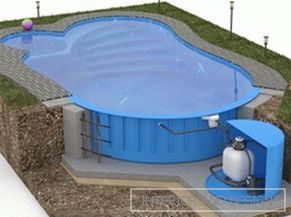 Pricing policy for plastic pools is quite acceptable, and the cost each individual model can be calculated depending on the dimensions, volume, type of construction and materials used, as well as additional elements in the form of steps, slides, stairs, lighting
Pricing policy for plastic pools is quite acceptable, and the cost each individual model can be calculated depending on the dimensions, volume, type of construction and materials used, as well as additional elements in the form of steps, slides, stairs, lighting
For example, the cost of a round polypropylene basin without any additional additions varies from 60 thousand rubles. за обьём 4,7 м3 up to 216 thousand rubles. for 42.5 m3. Polypropylene pool rectangular medium-sized forms with a length of 5 m and a width of 3 m has a cost of approximately 175 thousand rubles. The depth in this case, both in the first and in the second version, is in the limit of 1.5 m. Polypropylene pools are usually made to order within 7–14 days.
TOомпозитные бассейны имеют более высокую the cost и представлнены на рынке в виде уже готовых моделей различной конфигурации. Так, бассейн из стеклопластика длиной в 10 м, шириной в 3,7 м и глубиной 1,1−2 м при общем обьёме в 38 м3 will cost about 749 thousand rubles. The smallest bowl volume is 8 m3 можно приобрести за 208 тыс. руб. Стоимость полного комплекта дополнительного оборудования как для полипропиленовых, так и для composite pools составляет about 58 thousand rubles.
Technology installation of a plastic pool in the country
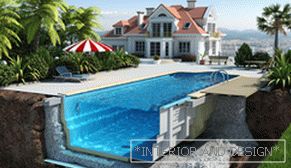 Whatever type of plastic pool is chosen, properly prepare grounds it should be anyway, but since the installation technology of the recessed types of pools provides for a number of procedures, we will consider their installation step by step:
Whatever type of plastic pool is chosen, properly prepare grounds it should be anyway, but since the installation technology of the recessed types of pools provides for a number of procedures, we will consider their installation step by step:
- Choice of place. Properly selected area under the pool is the key to its reliable and long-term operation. Thus, the surface should be strictly horizontal and level, and the groundwater level should be as low as possible from the bottom of the basin, at least 20–25 cm apart. Otherwise, it would be better to install a ground basin. There should not be trees nearby, as their roots can damage the structure over time;
- Digging pit. Dimensions of the pit are completely dependent on the size of the pool, but in any case it should be 15 cm larger than a bowl on each side. The depth corresponds to the depth of the reservoir and the height of the preparatory layers, which in general will be 250–300 mm;
- Arrangement of cement-sand "pillows". After the foundation pit is ready, a 50 mm thick cement-sand layer is laid on its bottom. To do this, prepare a solution in which the ratio of cement and sand is 1/3. This screed should dry for about three days, then proceed to the next stage of work;
- Formwork casting. Сначала укладывается армирующая проволка толщиной не менее 10 мм, которую обьединяют в ячейки (по 20−25 см). Затем поверхность заливается цементно-песчаным раствором. Толщина опалубки составляет около 200 мм. После того как опалубка высохнет, следует ещё раз выровнять grounds слоем в 20 мм;
- Bowl installation. A foam plastic with a thickness of 50 mm is placed on the finished bottom plate, on which the basin of the pool is installed. Then gradually the tank is filled with water, and the distance between the bowl and the edges of the pit is filled with cement-sand mixture, which is poured with water and carefully tamped. For example, if the water in the pool is poured 40 cm at a time, then the mixture is placed at the same height. This completes the installation of the plastic pool.
Finally
Today, plastic pools are exactly those irreplaceable designs, which make it quite easy to create the perfect place for outdoor activities and relaxation right at your dacha. Moreover, the ratio of price and quality is more than acceptable, and the variety of sizes, shapes and colors allows you to choose the best option for everyone.


